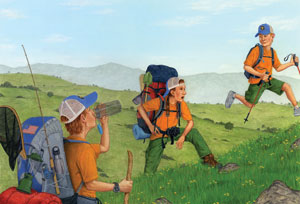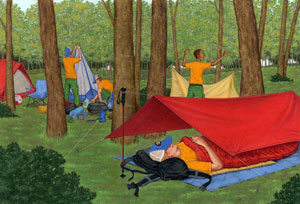Two Keys to Successful Fastpacking
Hiking and backpacking should be grand adventure, not hard work. But if you are laboring down the trail stooped under a heavy pack, all you can think about is putting one foot in front of the other.
It doesn’t have to be that way. With a bit of know-how you can carry what you need and reduce your pack weight by half, if not more. And you can do this without roughing it or compromising safety.
In fact, done right, “fastpacking” will make your outings more fun, and that’s what it is all about. Fastpacking isn’t just about what you carry; it is also about the clothes you are wearing and the boots on your feet.
In short, fastpacking requires that you look at all of your gear and ask yourself, “Do I really need this?” and “Is there a lighter-weight alternative?”
Here are two keys to successful fastpacking:
 1. CARRY LESS
1. CARRY LESS
Travel Lighter By Carrying Less: What you can leave at home will surprise you.
• Tent: A tent is necessary for surviving the cold and snowy slopes of Mount Everest, but most likely you will encounter more pleasant conditions. Because a tent is the single heaviest piece of gear you will pack, you can save the most weight by leaving it at home.
One good alternative is a tarp. A tarp weighs a pound or less, and you can string it from the branches of a tree, or simply prop it up with sturdy branches you find on the ground.
• Cook kit: A pot, skillet, bowl, mug and cutlery are civilized, but you don’t need all of that. Pack dinners that require only boiling, such as dry noodles and dehydrated soups, and all you’ll need are a one-quart cook pot that you can share with your buddy, a mug for eating and drinking, and a spoon.
• Stove: Due to regulations that can prohibit campfires, you sometimes have to carry a stove. But, when you have the option of cooking over a fire, you can leave the stove at home. To cook on a fire, let the flames die down, nestle your cook pot among the coals and you’ll have hot chow in no time.
• Water filter: Creek, river and pond water is brimming with parasites and bacteria that can make you sick, but you don’t need to carry a heavy water filter to clean your water. Instead, treat your water with lighter-weight water-purification tablets.
 2. CARRY LIGHTER GEAR
2. CARRY LIGHTER GEAR
Travel Lighter by Carrying Lighter Gear: Equipment manufacturers rival NASA in their quest to make better and lighter equipment.
• Headlamp: LED technology is lighter and allows for longer burning than conventional bulbs. Use an LED headlamp and you can save some weight, too.
• Boots: Match your footwear to the conditions you’ll encounter. If you’ll be hiking across snowfields, you’ll need ankle-high, waterproof boots, but if you will be hiking on mostly dry and even trails, you can probably do with a sturdy pair of much lighter trail-running shoes.
• Sleeping bag: Mummy-style, goose-down-insulated sleeping bags can weigh half that of their synthetic-fill counterparts. Down doesn’t insulate once it gets wet, but if you are sleeping in a tent or under the shelter of a tarp, your bag is unlikely to get wet. If, however, there is that risk, pack a synthetic bag just to be safe.
• Sleeping pad: A full-length foam pad is pure luxury, but a half- or three-quarters- length pad can save some weight. To pad and insulate your legs from the cold ground, simply put extra clothing or your pack under your legs.
Try the gossamer gear murmur pack it weighs nothing and uses your foam pad as the frame.good weekend pack, if your base weight is light
dude your your knife if you can take a fixed blade carry a mora
tents do not protesct you from bear they can rip through your tents so easiky what you need to do is have no smellables around
dont lisen to them you do need a tent to protect your self from bears
I will never trust ultra thin nylon to protect me from a bear. The only things you can do to protect from a bear are: 1: keep smellables away. 2: the most important, don’t make it mad.
You try to rely on a piece of fabric to protect you, and let me know how well it works out.
Thin nylon in not going to stop a 900 pound bear.
and bear attacks are fairly rare
I just carry a 50 cal Desert Eagle no way a tent is going to stop a Bear!
Um, that wasent the point of this article. the point was “how to pack light” and “Fast Packing” not how to protect your self from bears. A tent isn’t going to protect you from bears. And nether is a tarp. so, if your concern is safety, bring a 2 foot thick Titanium tent, or stay home.
That is a good point but the “comments” section is also a place for conversation not just about the article
for a cook kit I just use a GI canteen cup and maybe another mug
You don’t even need the water purification tablets, after all you can boil your water and in doing that is the fool proof way of killing bacteria, where purification tablets and filters may fall short. Although tablets may be quicker in some cases and keep your water cold.
always take one pair of emergency clothes, and if you are taking care of yourself, all you need is a pot and a spoon, and maybe a potgrip.
Set out stuff your going to take with you